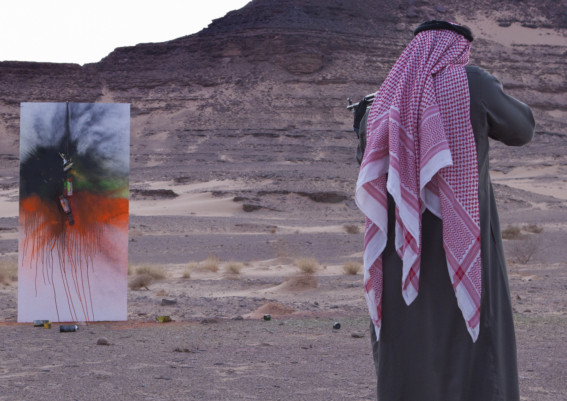
Zhivago Duncan is of Syrian and Danish origin. He was born in the United States, spent his childhood in Saudi Arabia, studied art in London and has also lived in Malta, Bulgaria, France and Germany. The artist’s work reflects his multicultural upbringing and his unique understanding of the dialogue between different cultures. In his latest exhibition, “As the Jungle Weeps”, Duncan explores notions of lost identity and forgotten culture, investigates misconstrued perceptions about cultural differences, and questions physical and moral truths.
In contrast to what the title of the show suggests, the artworks were created in the desert of Wadi Rum in Jordan, where the artist camped with the Bedouins and explored the desert, the farmlands of Rum and the port town of Aqaba. He has used rifles, guns, bulldozers, sand and his camera to create artworks that reference the history, culture and socio-politics of the region as well as the cultural cross-currents in today’s globalised scenario. On a personal level for the artist it was a nostalgic journey to the past in a bid to understand the present.
“I have a special affinity for the desert because during my childhood in Saudi Arabia, my Danish father often took us camping in the desert. But before going to Jordan I was working in the jungle in South America and the title of this body of work refers to the diverse influences in my life. The reference to the jungle alludes to misconstrued Western perceptions about this region being dangerous, which was quite contrary to my own experience of the warmth and hospitality of the people. The title also refers to the weapons being used in civil wars in the jungle and the desert, and which I also used for creating my artworks. And it also reminds us that once upon a time this arid desert used to be a water bed,” Duncan says.
Visitors to the show are greeted by a fibreglass horse standing in a trough of red sand from Wadi Rum. Duncan found this old, mechanical coin-powered children’s ride in Aqaba. “I was fascinated by the fact that this horse greets you in Mandarin Chinese, and rocks to Arabic music,” he says. The exhibit also features in a photographic work titled “Patina of Time”, where the Chinese-speaking horse stands in the desert against the backdrop of the mountains of Wadi Rum. “The idea behind this picture was to imitate the art typically seen on album covers of American bands, and to misplace those overdone pop cultural references in the home of the Bedouins in a sort of cultural acupuncture,” Duncan says.
The central pieces of the show are two works that the artist specially staged in the desert. One is a multichannel video, titled “Titan”. “Before leaving for Jordan I had a dream where a bulldozer was slowly dumping a load of sand, while the image of an explosion — taken from a classic 1960’s American cartoon — was projected on the sand spilling out from its blades. I recreated this dream at a construction site in the desert. The juxtaposition of the giant bulldozer, which is a machine of destruction and construction, and the repeated explosions evokes what is happening now in the Middle East,” Duncan says.
The same combination of explosions and machines of destruction and domination is seen in the other work named “Folklore”. Here the artist set up in the desert, a series of panels mounted on jacks to mimic an American military-style shooting range. He stacked cans of spray paint in front of each panel and along with his companions aimed at the cans with AK-47’s, shotguns and 9mm handguns. The result is a series of “paintings” featuring an explosion of colours and bullet holes. Interestingly, one canvas remained unstained, and the artist has decorated it with a string of the unexploded cans.
“I named this work ‘Folklore’ because it ties together the abundance of matter and myth of the old-school debauchery of American heroes such as Hunter Thompson and William Burroughs with the mysticism of 1001 Nights. Right now, bullets are difficult and expensive to obtain in the Middle East due to the war in Syria. So, I felt guilty about using the bullets, but also happy to take them away from war and into art. Hence, by making these works in the deserts of Rum, I challenged both physical and moral truths,” Duncan says.
Another interesting piece is a glass bottle filled with coloured sands that Duncan got from a souvenir shop in Petra. “Bedouin sand artists usually create decorative patterns, desert scenes and tourist names inside these bottles. But I asked them to create the Visa logo that I saw everywhere in this historic site,” he says. Presented in an antique wooden cabinet, the bottle titled “Sands of Time” comments on globalisation and the paradox between socio-economic evolution in the modern world and the devolution of regard towards the ancient worlds.
“During this trip I listened to my surroundings and intuition, and the works just happened. I was searching in the desert for that sweet something for the soul, and I found a warm welcome, the universal laws of communal understanding and the basic essence of humanity,” the artist says.
Jyoti Kalsi is an arts enthusiast based in Dubai.
“As the Jungle Weeps” will run at JAMM art gallery in Al Quoz until April 19.











